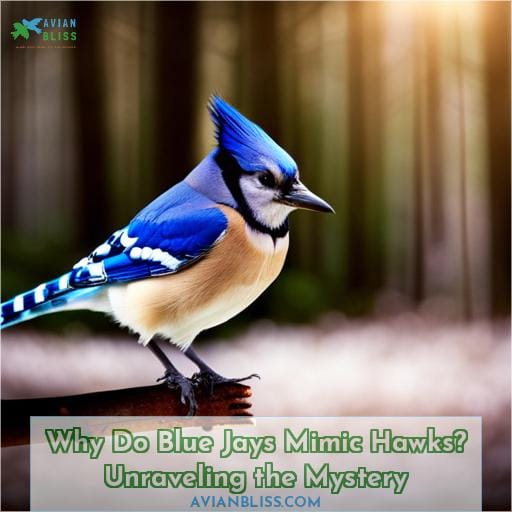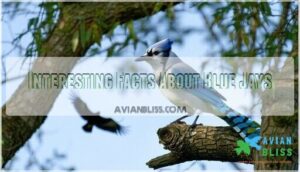This site is supported by our readers. We may earn a commission, at no cost to you, if you purchase through links.

To answer this question we must journey through the fascinating world of bird behavior to understand how and why they use their vocalizations for communication. From nest protection strategies to interesting facts about their coloration and feeding habits; unraveling this mystery will give us an appreciation for these amazing creatures.
So join us on our exploration into why blue jays mimic hawks!
Table Of Contents
Key Takeaways
- Blue Jays mimic hawks to alert other birds about potential aerial threats and create a safer environment.
- They take advantage of smaller birds scattering when they hear hawk-like calls to secure easy access to food.
- Mimicking hawks aids in nest defense and deters potential predators.
- Hawk mimicry is a communication strategy used by Blue Jays to coordinate activities, convey information, and assert territorial dominance.
Why Do Blue Jays Mimic Hawks?
Ever wondered why those forest-dwelling avian tricksters put on their best feathered impersonation of the sky’s apex predators? Blue Jays mimic hawks for a fascinating blend of reasons deeply rooted in their behavioral strategies.
One primary motive is hawk warning. When Blue Jays mimic the calls of hawks like Red-tailed or Cooper’s Hawks, they alert other birds in the area of a potential aerial threat. This altruistic act can be seen as a form of community service, ensuring the safety of their feathered neighbors.
Additionally, predator deception plays a role. By mimicking hawks, Blue Jays can deceive other bird species. When smaller birds hear the hawk-like calls, they often scatter, leaving behind valuable food sources like bird feeders.
This feeding strategy provides Blue Jays with easy access to food, demonstrating their clever and opportunistic nature.
Furthermore, the mimicry aids in nest defense. When Blue Jays have eggs or chicks to protect, mimicking hawks may deter potential nest predators, as the presence of a hawk is perceived as a danger.
In essence, Blue Jays’ mimicry of hawks serves as a multifaceted tool for enhancing their survival, fostering communal safety, and securing food sources. It’s a remarkable example of avian intelligence and adaptability in the natural world.
Theories Behind Blue Jays’ Hawk Mimicry
To shed light on the mystery of hawk-like calls in these songbirds, consider this: imagine a clever disguise that keeps intruders at bay while you go about your business, much like how a skilled actor assumes different roles to deceive the audience.
Hawk Warning: Blue Jays use their mimicry skills as a form of hawk warning. When they imitate the calls of predatory hawks like Red-tailed or Cooper’s Hawks, it alerts other birds in the area to potential danger. This not only protects the jays themselves but also creates a safer environment for other bird species.
Communication Strategy: This mimicry serves as a communication strategy within the jay community. It helps them coordinate activities, warn of threats, or convey information about food sources without directly revealing their location or intentions.
Predatory Mimicry: By mimicking hawks, Blue Jays may deter smaller birds from approaching their territory or food sources, giving them an advantage in securing resources.
Bird Behavior: This behavior showcases the complexity of avian mimicry and highlights the adaptability and resourcefulness of Blue Jays in their quest for survival and dominance in their habitat.
Possible Explanations for Blue Jays’ Hawk-Like Calls
Wondering why those clever birds in your backyard imitate hawks? Blue Jays exhibit hawk mimicry as part of their intricate communication strategies. This behavior serves various purposes, providing them with an evolutionary advantage in the wild.
One key function is to act as a form of predatory behavior, startling other birds and potentially deterring them from approaching the Blue Jay’s territory or food sources. Moreover, these distinct vocalizations also serve as a communication method within their species, helping Blue Jays convey information about potential threats.
By mimicking species of hawks, Blue Jays effectively employ a predator warning system that alerts others to the presence of potential danger. This fascinating behavior highlights the adaptability and intelligence of these birds, showcasing their ability to manipulate their vocal repertoire to ensure their survival in their habitat.
How Blue Jays Use Hawk Calls for Nest Protection
Picture this: In the world of birds, it’s like having a security system for your home; these avian impostors use hawk calls as their winged alarm system. Blue jays are no ordinary mimics; they employ their vocal signals strategically for nest protection.
Deterrent Effect: Blue jays mimic hawk calls to ward off potential nest predators, a behavior that reflects their complex social systems. The realistic imitation of a predator’s presence can make other birds think twice about approaching a blue jay’s nest.
Deception and Distraction: When blue jays mimic hawks, it can also be a clever ruse. They may imitate hawks to distract other birds, leading them away from their own nests while safeguarding their own precious eggs and chicks.
Communication with Conspecifics: These hawk-like calls aren’t just for show. Blue jays also use them to communicate with fellow jays, signaling potential threats and coordinating defense efforts.
Territorial Assertion: In some instances, mimicking hawks can be a way for blue jays to assert territorial dominance, sending a message to neighboring birds that they mean business.
So, next time you hear a blue jay belting out a convincing hawk call, remember that it’s not just mimicry for fun; it’s a crucial part of their protective behavior and avian communication strategy.
Interesting Facts About Blue Jays
Delving deeper into the intriguing world of Blue Jays, you’ll discover fascinating aspects of their existence. From the science behind their striking blue plumage to their clever mimicry of hawks, Blue Jays’ coloration and feeding behaviors, as well as their vocalizations and communication strategies, unveil captivating insights into their survival and interaction within their ecosystem.
Blue Jays’ Color and Feeding Behavior
Explore the fascinating connection between the vibrant plumage coloration of Blue Jays and their feeding behavior. The blue color in their feathers results from light refraction over underlying brown melanin pigment.
Known for plundering nests and frequenting bird feeders, these omnivores play a vital role in forest reseeding by gathering and storing nuts. Their mimicry tactics, including hawk calls, serve both as warnings to other birds and clever ruses to access food sources.
Blue Jays’ distinctive color and feeding habits make them intriguing contributors to the ecosystem.
Blue Jays’ Vocalizations and Communication
To add intrigue to their repertoire of vocalizations, Blue Jays integrate mimicry of various hawk species, such as Red-tailed, Red-shouldered, Cooper’s, and Broad-winged Hawks, into their communication, often employing this tactic when they’re excited.
This mimicry serves multiple communication strategies. Firstly, it can act as a warning signal to other birds in the area, alerting them to the potential presence of a predatory hawk. Secondly, it may deceive other species, creating confusion and giving Blue Jays an advantage, especially when accessing bird feeders.
This remarkable behavior showcases the Blue Jay’s complex and adaptable communication skills.
Conclusion
Blue Jays are mysterious songbirds, and their ability to mimic hawks has long been an intriguing puzzle. From Julie Craves’ research, we now know that Blue Jays mimic hawks to protect their nests, to access feeders, and to startle other birds.
This behavior is a reminder of the complexity and intelligence of these birds, displaying their creativity and resourcefulness. Moreover, Blue Jays’ color and feeding behavior, vocalizations and communication, and anting behavior all contribute to a richer understanding of their behavior.







